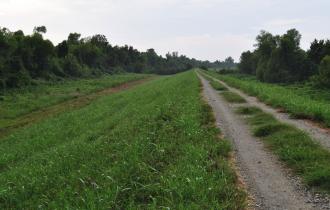News Taffy
| Post Your News Send Us An Event Start A Gallery |  |
| Most Recent | Most Popular | Top Contributors | Galleries | Events |
News Article
 | Contributor: admin subscribe to my stories |
 Green Engineering and Levees With the current controversy surrounding the area's levees andFederal Emergency Management Association (FEMA) concerns with how likely they are to protect us in a large flood (with associated flood insurance considerations), this might be a good time to look at the latest thinking on levee construction and maintenance. Most of the levees in this area are earthen, and using soil in construction presents special considerations for coping with levee/plant interactions and long-term levee maintenance and safety. The construction and continued stabilization of earthen levees are engineering challenges met in many ways. Factors considered include how high a severe flood is likely to reach, the type of soil available from local borrow pits for construction and associated seepage considerations, steepness of the slope and height of the levee, and the long-term effects of plants growing in a levee site prior to construction and also those plants likely to colonize the levee post-construction. Currently, levee designs stipulated by the U.S. Army Corps of Engineers (USACE) call for elimination of all woody plants including trees and any shrubs large enough to develop a significant root system. Only shallow-rooted turf grass is planted or allowed to grow, and this is maintained with regular mowing at significant labor cost, fossil fuel use, production of air pollution and low ecological service value in terms of wildlife and fish habitat and water quality benefits. The idea is that roots from trees and large shrubs can damage earthen levees. Such damage would occur from toppling of trees in storms, causing uprooting and the creation of a major hole, or the eventual natural death and decomposition of large tree roots, allowing seepage. Both types of damage can eventually cause a catastrophic structural failure. New ideas in the construction and incorporation of trees, shrubs and tall native grasses into design of levees are being developed. Research by the USACE and others show that plant roots can add significantly to soil strength when the levee is properly designed, with up to a five-fold increase in soil shear resistance (removal of soil by flowing water) by some grasses and trees, reducing the natural breakdown of levees over time. The integration of vegetation into engineered soil structures, including levees, is called bioengineering. While the idea is not new and has been practiced in some form for centuries, it is being increasingly applied by federal agencies and consulting firms specializing in designing and building structures which strike a balance between ecological productivity and structural integrity. Some benefits of including native vegetation for soil stabilization on earthen levees are (from The Bioengineering Group, Baton Rouge, La.) - More durable, reliable vegetative cover on embankments than turf grass, - Deeper rooted species provide better drought tolerance and higher strength, - Small patches or rows in select spots can add high habitat value amidst mown areas, - Many native shrubs and grasses can be mown annually to allow for easy inspection, - Reduced mowing frequency can minimize costs, air pollution and habitat disturbance, - Mown biomass can serve as biofuel or co-burning stock, offsetting mowing cost, - Vegetated slopes can capture and store carbon faster than fuel is burned for mowing, - Many species are well adapted to allowing additional soil fill to be placed over time, - Plants have capacity for regeneration and self repair after impacts cause minor damage, - Trees provide shade to maintain cool temperatures and good oxygen levels in rivers, - Trees provide resting and nesting spots for birds and wildlife dependent on bank habitat. Because of the above benefits, the idea that woody vegetation on levees is always negative has slowly been dissipating. Although vegetation policy enforced by the USACE has not yet changed, regulatory variances are being approved that allow trees to remain on levees under certain circumstances where it can be demonstrated that the levees will still meet acceptable standards of safety and long-term integrity. Such an example occurs in California, where trees remain on 42 miles of levee near Sacramento. Increasingly, collaboration between public works engineers, environmental scientists, land use regulators, and local stakeholders is helping to develop the merits and application of practical solutions towards incorporating woody vegetation into levee design. This allows benefits to accrue through reduced cost of construction and maintenance, and increased ecological services within valuable waterways. [+] add comment |














